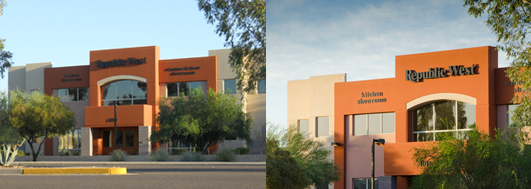How to prepare for a business photo shoot
For many businesses, photography can be such an important part of putting your best foot forward. However, many people don't take proper considerations before taking their photos. Here are a few tips for how to prepare for a business photo shoot.
Professional photography makes a huge difference. I can't tell you how many times I've heard clients say "I have a nice camera, I can take my own photos." Unfortunately, what makes a great photo has very little to do with the equipment. What makes a fabulous photo is the consideration of composition, lighting, framing, angles and many other elements that take the skilled eye of an artist to capture.Although it is tempting to think you can do this step yourself, take a look at the comparison below to see the difference between a photo I took myself and one taken of the same subject by a professional photographer. The photo on the left was taken by myself with my high-res digital camera. The photo on the right was taken by local professional photographer, Wendy Martinez.
As a designer I have a good eye for layout, and you'd think I could take a decent photo, but when you compare my photo with a professional's photo, you can see how much more the professional photo captures the spirit of the subject and how it is technically much better in terms of composition, framing, lighting, etc.
“What makes a fabulous photo is the consideration of composition, lighting, framing, angles and many other elements that take the skilled eye of an artist to capture.”
Consider orientation
Although a photographer has the ability to take amazing photos, they can't possibly know where you intend to use them, so you'll want to have a discussion with them about the type of photos you need and where you intend to use them. When you are having this discussion, make sure you talk about whether you need your photos taken at vertical or horizontal orientation. You'll want to consider where you want to use your photos. For example, if you are looking to use your photos in the large main image area on your website, you'll definitely want to make sure you get lots of horizontal photos. However, if you are looking to use the images in more of a brochure-style context, vertical orientation might be what you need. If in doubt, make a point to ask the photographer to shoot each shot type at both orientations just to be safe.
Get close up—and far away
Likewise, you'll want to consider how closely zoomed the images should be. Lots of people—especially photographers—love zoomed-in photos because they are very artistic and intriguing. However, you need to consider how you'll be using the photos to know how close is appropriate. Let’s use the example again of a photo that would be showcased in a horizontal band on your website home page. This area isn't usually as tall as the images a photographer would take, which means you'd have to crop some of the image off the top and/or bottom of the image. If the image is zoomed in too far, the image could end up looking too abstract. It is important to consider issues like this and communicate them to your photographer before the photo shoot in order to get the most useful photos possible.
Make a list and check it twice
Although a professional photographer might be incredibly talented, they aren't a mind-reader. Make them a list of the different photos you need them to take. This is called a shot list. Doing this will help give the photographer good direction and will ensure that you get the images that you need for your marketing materials. Compiling a list helps you mentally catalog what photos you'll need and gives your photographer a roadmap of what images should be taken. If you forgo compiling a shot-list to guide your photographer, they may take that to mean that they should just take images of what they feel is interesting, which may produce disappointing results if these images are not the photos you need. A simple shot-list would look something like this:
Head-on view of the building front
3/4 view of the building front
Multiple angles of sign
Front desk with receptionist working
Front desk with receptionist posed and smiling
Candid action shots of your CEO working
Posed shot of your CEO at their desk
And so on...
Less is not more
If you know me at all, you know I'm a big fan of the adage, 'less is more.' However, when it comes to a photoshoot, less is not more. Make sure you plan an adequate amount of time for your photoshoot and request that the photographer takes lots of variations of the photos you need. You never know when an angle you never considered will be exactly what you need to make your business or product shine.
Keeping these items in mind will help make the most of your photoshoot and give you lots of flexibility for how you could use the images captured. If you're in need of a professional photographer and don't know who to call, feel free to reference this handy list of photographers I know and love.

